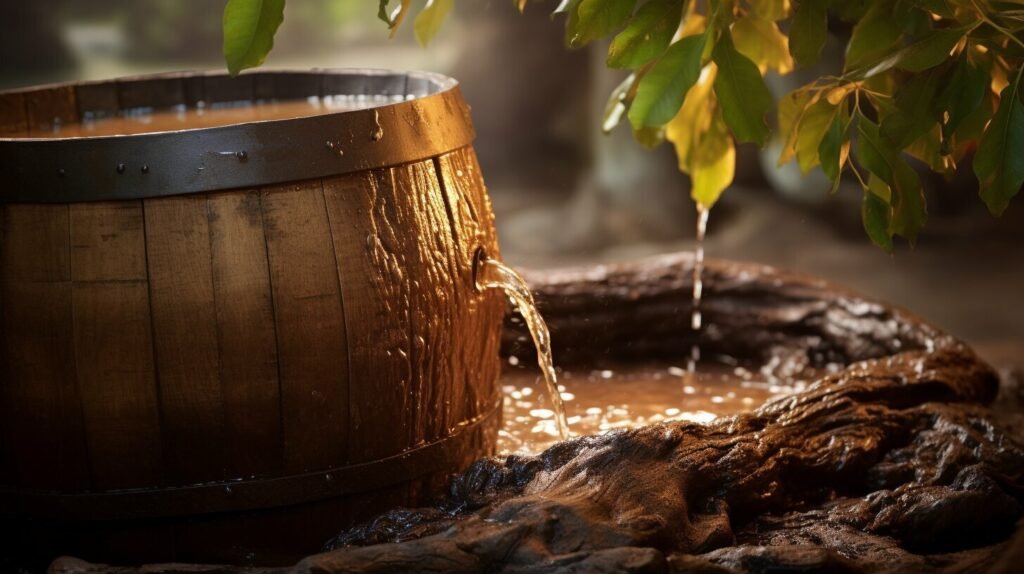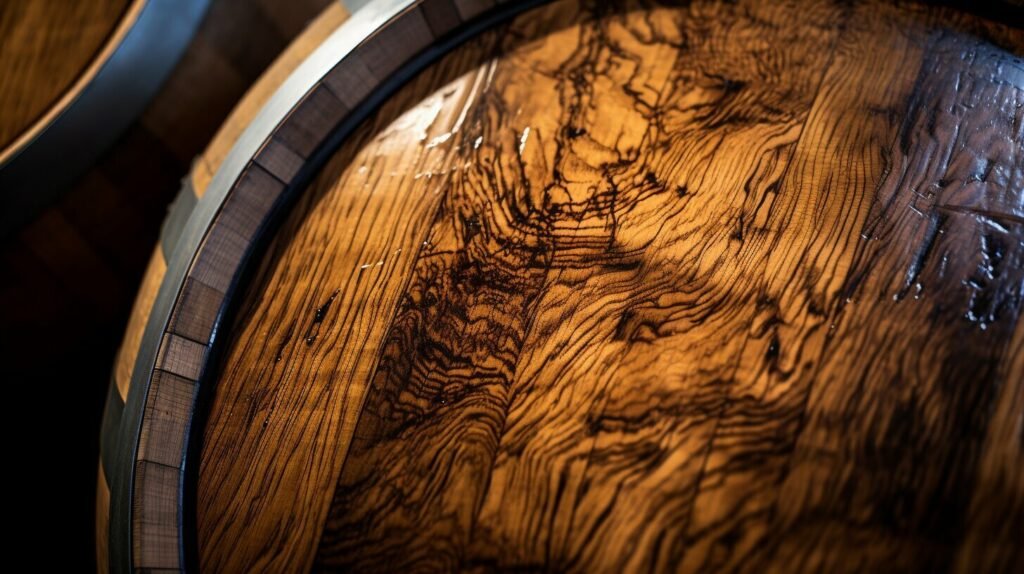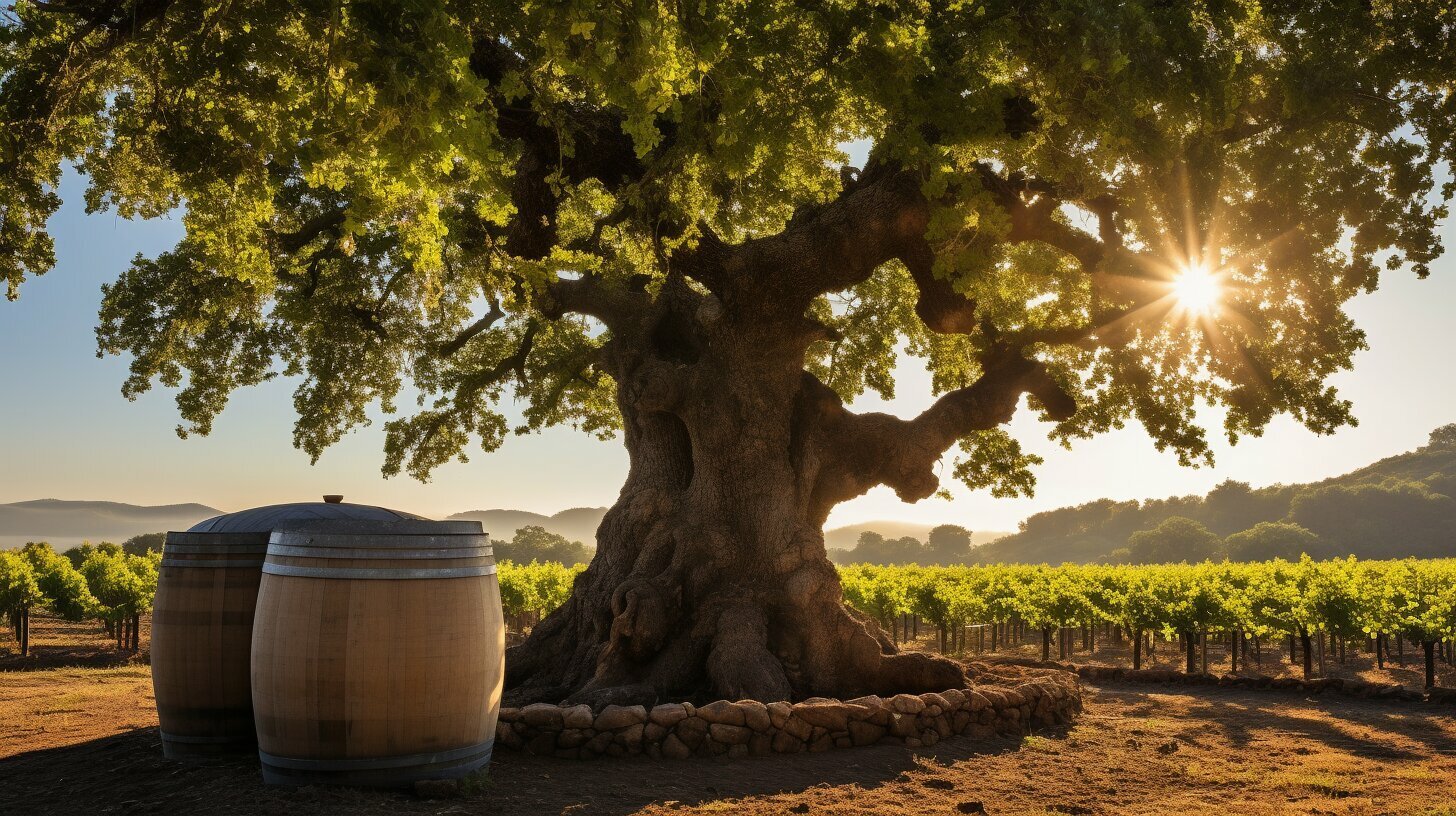Oak aging is a centuries-old technique that has been used in winemaking to enhance and shape the flavor profile of wines. Oak barrels have played a significant role in the process, imparting unique characteristics and adding depth to the final product. In this section, we will explore the deep connection between oak trees and wine, particularly focusing on the influence of oak aging on wines and spirits.
- Oak aging is a traditional winemaking technique that enhances the flavor profile of wines.
- French oak is highly regarded, while American oak is denser and more affordable.
- Toasting oak barrels over a flame at different levels produces distinct flavor traits in the wine.
- Oak aging improves stability and softens harsh characters in wines.
- The duration of oak aging depends on factors such as barrel size, age, toast level, and oak variety.
In the following sections, we will delve deeper into the profound influence of oak aging, the differences between French oak and American oak, the toasting techniques and flavor profiles, and the innovations in oak aging. We will also discuss the impact of oak aging on home winemakers and conclude by highlighting the significance of oak aging in enhancing the flavor and character of wines and spirits.
The Profound Influence of Oak Aging
Oak aging plays a crucial role in enhancing the flavor and character of wines, thanks to its profound influence on the aging process. For centuries, winemakers have relied on oak barrels to impart unique characteristics to their wines. The choice between French oak and American oak is a significant consideration, as each type offers distinct flavors and aromas.
French oak is highly regarded in the winemaking world for its refined qualities. It is known to add subtle notes of vanilla, spice, and toastiness to the wine. On the other hand, American oak is denser and more cost-effective, providing bolder flavors of coconut, caramel, and dill. Both types of oak contribute to the overall complexity and depth of the wine.
Toasting is a crucial step in the oak aging process. Winemakers carefully control the level of toasting to achieve desired flavor profiles. Light toasting imparts delicate flavors, while heavy toasting adds deeper, smoky notes. This artful process allows winemakers to create a diverse range of wines with varying oak influences.
The Impact of Oak Aging on Wine Flavor
The influence of oak aging on wine flavor is best understood through tasting notes. Wines aged in oak barrels often exhibit flavors of vanilla, cedar, tobacco, and spices like cinnamon and clove. These nuanced flavors, combined with the natural fruit characteristics of the wine, create a harmonious and complex taste experience.
Oak aging also enhances the stability of wines, allowing them to develop gracefully over time. The oak acts as a natural preservative, protecting the wine from oxidation and imparting a subtle smoothness. Additionally, the interaction between the wine and the oak softens any harsh characteristics, resulting in a more balanced and enjoyable drinking experience.
| Type of Oak | Flavor Characteristics |
|---|---|
| French Oak | Vanilla, spice, toastiness |
| American Oak | Coconut, caramel, dill |
With oak aging playing such a vital role in shaping the flavor profiles of wines, it is no wonder that winemakers consider it an essential technique in their craft. The careful selection of oak, toasting techniques, and duration of aging all contribute to the final masterpiece in the bottle. So, the next time you savor a glass of oak-aged wine, take a moment to appreciate the artistry behind its creation and the profound influence of oak aging.

When it comes to oak aging, French oak and American oak have distinct qualities that contribute to the flavors and aromas of wines. French oak is highly regarded in the winemaking industry and is often considered the pinnacle of oak for crafting high-quality wines. It is known for its tight grain and subtle flavors, which allow the wine to develop complex and delicate characteristics over time. French oak barrels are typically used for aging premium wines due to their subtle influence and ability to enhance the wine’s structure without overpowering its natural flavors.
On the other hand, American oak is denser and more porous than its French counterpart, resulting in a more pronounced and assertive flavor profile. American oak barrels tend to impart stronger notes of vanilla, coconut, and dill to the wines, giving them a distinct flavor that is particularly well-suited for bold, fruit-forward wines. Additionally, American oak barrels are more affordable, making them a popular choice among winemakers who seek to achieve a robust oak influence without breaking the bank.

Oak Aging Process Comparison
| French Oak | American Oak | |
|---|---|---|
| Grain | Tight | Dense |
| Flavor Profile | Subtle, complex | Pronounced, vanilla, coconut, dill |
| Pricing | More expensive | More affordable |
| Commonly Used For | Premium wines | Bold, fruit-forward wines |
Both French oak and American oak impart unique qualities to the wines they age, allowing winemakers to create a diverse range of flavors and aromas. The choice between the two depends on the desired style of the wine and the winemaker’s preferences. Some winemakers even choose to combine the two types of oak to achieve a harmonious balance of flavors and complexities in their wines.
Toasting Techniques and Flavor Profiles
The toasting techniques used during the oak aging process greatly influence the flavor profiles of wines, often resulting in rich and complex characteristics reminiscent of whiskey. Oak barrels are carefully toasted over a flame, allowing the wood to release compounds that interact with the wine and impart unique flavors. The level of toasting determines the intensity and nature of these flavors, making it a crucial step in the oak aging process.
Light toasting creates delicate flavors such as vanilla, while medium toasting enhances the wine with caramel and toasted bread notes. Heavy toasting, on the other hand, produces bolder flavors like coffee, chocolate, and smoky undertones. The choice of toasting level depends on the winemaker’s desired flavor profile and the type of wine being aged. It’s fascinating to see how these different toasting techniques can transform a wine, adding depth and complexity to its overall character.
One of the interesting aspects of oak aging is the development of whiskey-like flavors in certain wines. The interaction between the wine and the charred interior of the oak barrel creates flavors reminiscent of aged spirits, resulting in a unique sensory experience. This characteristic is particularly sought after in some red wines, where the whiskey notes complement the fruity and tannic qualities of the wine, adding layers of complexity and intrigue.

| Toasting Level | Flavor Profile |
|---|---|
| Light | Vanilla, delicate notes |
| Medium | Caramel, toasted bread |
| Heavy | Coffee, chocolate, smoky undertones |
By understanding the influence of various toasting techniques on the flavor profiles of oak-aged wines, winemakers can craft unique and captivating products that leave a lasting impression on the palate. Whether it’s the subtle sweetness of vanilla or the bold richness of dark chocolate, these flavors contribute to the overall complexity and enjoyment of the wine. The art of oak aging continues to evolve, pushing the boundaries of creativity and innovation in winemaking.
Enhancing Stability and Softening Profiles
Oak aging not only imparts flavors but also enhances the stability of wines, while simultaneously mellowing any harsh characteristics. When wines are aged in oak barrels, the wood imparts certain compounds that help to stabilize the wine and protect it from oxidation. This is especially important for red wines, which contain higher levels of tannins that can react with oxygen and lead to spoilage. The porous nature of oak allows for a slow and controlled exchange of oxygen, contributing to the maturation and development of the wine.
In addition to stability, oak aging also softens the harsh characters that may be present in young wines. This is due to the interaction between the wine and the compounds present in the oak, such as tannins and lignins. These compounds help to smooth out the wine, making it more balanced and enjoyable to drink. Oak aging can also contribute to the development of complex flavors, adding layers of depth and richness to the wine.
To demonstrate the impact of oak aging on stability and flavor profile, let’s take a look at the following table:
| Wine | Aging Method | Stability | Flavor Profile |
|---|---|---|---|
| Chardonnay | Stainless steel tank | Low | Fresh, crisp, fruity |
| Chardonnay | Oak barrel aging | High | Buttery, creamy, vanilla |
| Merlot | Stainless steel tank | Low | Fruit-forward, medium-bodied |
| Merlot | Oak barrel aging | High | Smooth, velvety, complex |
As you can see from the table, wines that undergo oak aging exhibit higher stability and a more complex flavor profile compared to wines aged in stainless steel tanks. The oak imparts desirable characteristics like creaminess, vanilla, and complexity, elevating the overall quality of the wine.
So, the next time you savor a glass of oak-aged wine, take a moment to appreciate the role that oak plays in enhancing stability and softening the wine’s profile. It is through the careful marriage of wine and wood that winemakers can create truly exceptional and memorable drinking experiences.

The reusability of oak barrels and the choice of oak variety greatly influence the intensity of the oak flavors in wines, while the barrel size plays a significant role as well. Oak barrels have the unique ability to retain and impart flavors from previous uses, creating a layering effect that adds complexity to the final product.
When a barrel is reused, the oak flavors become less pronounced with each subsequent use. This is because the wood slowly releases its flavor compounds over time, resulting in a more subtle influence on the wine. However, the choice of oak variety can also impact the intensity of flavors. French oak, with its tight grain and higher tannin content, tends to impart more delicate and nuanced flavors compared to American oak, which is known for its bolder, sweeter, and more pronounced flavors.
Additionally, the size of the barrel used for aging can affect the intensity of oak flavors. Smaller barrels have a larger surface area-to-volume ratio, allowing for more contact between the wine and the oak, leading to a more pronounced oak influence. Conversely, larger barrels have less surface area in proportion to the volume of wine, resulting in a more subtle oak character.
Comparing Oak Barrel Sizes
Below is a comparison of the different barrel sizes commonly used in winemaking:
| Barrel Size | Volume | Characteristics |
|---|---|---|
| 225L (Standard Bordeaux) | 59 gallons / 300 bottles | Balanced oak influence |
| 300L (Hogshead) | 79 gallons / 400 bottles | Subtle oak influence |
| 500L (Puncheon) | 132 gallons / 660 bottles | Minimal oak influence |
As you can see, the choice of oak variety, barrel reusability, and barrel size all contribute to the final flavor profile of wines aged in oak barrels. Winemakers carefully consider these factors to create wines with the desired oak characteristics, striking a delicate balance between the fruit, tannins, and oak influence.

The traditional oak barrel has seen an innovative transformation with the introduction of the Squarrel, a sustainable alternative that offers greater flexibility in oak aging. Made from a square-shaped design, this new barrel revolutionizes the traditional oak aging process while prioritizing sustainability.
Unlike traditional round barrels, the Squarrel uses one-third of the wood required, making it more environmentally friendly. Its unique shape allows for easy stacking and efficient use of space during the aging process. This means that winemakers can maximize their oak aging capabilities without sacrificing valuable storage space in their cellars.
But the Squarrel isn’t just about sustainable design; it also delivers exceptional oak aging results. The oak wood used in each Squarrel is carefully selected to ensure the finest quality, imparting distinctive flavors and aromas to the wine. Whether it’s a rich vanilla note or a hint of toasted oak, the Squarrel brings out the best in every drop.

The Squarrel offers winemakers a customizable oak aging experience. With the ability to adjust the size, toast level, and age of the Squarrel, winemakers have greater control over the flavors and characteristics they want to impart to their wines. Whether it’s a bold Cabernet Sauvignon or a delicate Chardonnay, the Squarrel can accommodate the specific requirements of each wine.
Furthermore, the Squarrel’s design allows for easy access to the wine during the aging process. This means winemakers can regularly assess and taste the wine as it develops, ensuring they achieve the desired oak aging profile. It’s a truly hands-on approach that allows winemakers to craft exceptional wines with precision and expertise.
| Squarrel Features | Benefits |
|---|---|
| Stackable design | Saves valuable cellar space |
| Custonmizable size, toast level, and age | Allows for tailored oak aging profiles |
| Sustainable and eco-friendly | Reduces environmental impact |
As the demand for sustainable winemaking practices grows, the Squarrel is at the forefront of innovation in oak aging. It combines sustainability, efficiency, and exceptional results, making it a game-changer in the world of winemaking. Embrace the future of oak aging with the Squarrel and elevate your wines to new heights of flavor and complexity.
Duration and Factors of Oak Aging
The duration of oak aging varies based on several factors, including barrel size, age, toast level, and the type of oak used. Let’s take a closer look at each of these factors:
Barrel size: The size of the oak barrel plays a significant role in the duration of oak aging. Smaller barrels, such as 225-liter barriques, allow for greater surface-to-volume ratio, resulting in quicker oak extraction. Conversely, larger barrels, like 500-liter puncheons or 1,000-liter foudres, have a smaller surface area, leading to a longer aging process.
Age of the barrel: As oak barrels age, they can lose some of their aromatic compounds and become less effective in imparting flavors to the wine. New oak barrels provide more intense and pronounced flavors, while used barrels may require longer aging periods to achieve similar results. Winemakers carefully consider the age of the barrel to achieve the desired flavor profile.
Toast level: The toasting of oak barrels is a crucial step in the oak aging process. During toasting, the inside of the barrel is charred, releasing aromatic compounds that infuse the wine. Different toast levels, ranging from light to heavy, produce distinct flavors and characteristics. Light toasting enhances fruitiness and freshness, while heavy toasting intensifies smoky and vanilla notes. Winemakers choose the appropriate toast level based on the desired flavor profile.
Type of oak: The type of oak used for aging, such as French oak or American oak, contributes unique flavors and characteristics to the wine. French oak is highly regarded for its delicate structure and complex aromas, while American oak is denser and imparts stronger flavors. Each type of oak requires different aging times to achieve the desired balance and integration with the wine.
By carefully considering these factors, winemakers can determine the optimal duration of oak aging in order to achieve the desired flavor profile and balance in their wines.

In addition to barrel size, age, toast level, and oak type, there are other factors that can influence the oak aging process:
- Wine variety: Different grape varieties have varying levels of interaction with oak, affecting the duration of oak aging required to achieve the desired result.
- Climate: The climate in which the oak barrel is stored can impact the rate at which the wine interacts with the oak, influencing the duration of aging.
- Winemaking goals: The winemaker’s objectives for the wine, whether it’s to emphasize oak flavors or achieve a more subtle integration, can also determine the duration of oak aging.
It is essential for winemakers to carefully consider all of these factors, allowing them to craft wines that exemplify the desired oak aging characteristics and showcase the unique qualities of their vineyards.
| Factor | Influence on Oak Aging Duration |
|---|---|
| Barrel Size | Determines the surface-to-volume ratio, affecting the rate of oak extraction. |
| Age of the Barrel | New barrels provide more intense flavors, while used barrels may require longer aging periods. |
| Toasting Level | Light toasting enhances fruitiness, while heavy toasting intensifies smoky and vanilla notes. |
| Type of Oak | French oak imparts delicate structure and complex aromas, while American oak provides denser and stronger flavors. |
Understanding these factors and their influence on oak aging duration empowers winemakers to create wines that reflect their vision and deliver exceptional flavor profiles.
Oak Aging for Home Winemakers
Home winemakers can easily achieve oak aging effects through various methods, such as using oak barrels, oak chips, oak powder, or oak extractive. These techniques allow for the infusion of rich and complex oak flavors into their wines, enhancing the overall taste and aroma.
Oak Barrels: One traditional method is to age wine in oak barrels. These barrels provide a controlled environment for the wine to interact with the oak, resulting in the gradual release of oak flavors. The size of the barrel and the duration of aging will impact the intensity of the oak influence. To maximize the oak flavor, it’s recommended to use smaller barrels as they have a higher surface area-to-wine ratio. Additionally, the type of oak, such as French oak or American oak, will also contribute distinct flavors to the wine.
Oak Chips, Powder, and Extractive: For those who prefer a more convenient approach, oak chips, powder, or extractive can be used. Oak chips are small pieces of wood that can be added directly to the wine during fermentation or aging. Oak powder, on the other hand, can be dissolved in the wine for a quicker infusion of oak flavors. Oak extractive, a concentrated liquid derived from oak, offers a highly controlled method of adding oak flavors in precise amounts.
Experimentation is key when using these methods, as the desired flavor profile can be achieved by adjusting the quantity and duration of oak exposure. Whether you choose the traditional barrel aging method or opt for the convenience of oak alternatives, adding oak flavors to your homemade wine can elevate its complexity and depth.

| Oak Aging Method | Pros | Cons |
|---|---|---|
| Oak Barrels | – Provides controlled oak aging environment\n- Imparts complex oak flavors\n- Allows for gradual release of flavors | – Requires more storage space\n- Higher cost\n- Takes longer for oak flavors to develop |
| Oak Chips | – Convenient and easy to use\n- Faster infusion of oak flavors\n- Adjustable oak exposure | – Can be challenging to filter out the chips\n- May result in stronger oak flavors if not monitored carefully |
| Oak Powder | – Quick and efficient oak extraction\n- Highly customizable oak exposure\n- Easy to dissolve in wine | – Can be difficult to accurately measure quantities\n- May result in overpowering oak flavors if not used with caution |
| Oak Extractive | – Precise control over oak flavors\n- Concentrated and consistent results\n- Easy to measure and add to wine | – Limited availability\n- May be more expensive than other methods\n- Requires careful dosing to achieve desired flavors |
Conclusion
Oak aging is a timeless technique that continues to shape the world of wines and spirits, enriching them with delightful flavors and aromas. For centuries, oak barrels have been the go-to choice for winemakers due to their ability to enhance and shape the flavor profile of wines. French oak, widely regarded as the best oak for winemaking, brings its unique characteristics to the table, while American oak, denser and more affordable, offers its own distinct traits.
When it comes to oak aging, the toasting process plays a crucial role. The level of toasting imparts different flavor traits to the wine, with various levels of toast producing different results. This technique not only enhances stability and softens harsh characters in the wine but also adds wood flavors that contribute to a more balanced and enjoyable drinking experience.
Furthermore, oak barrels can be reused multiple times in winemaking, with their size impacting the intensity of oak flavors in the final product. However, recent innovations have introduced a sustainable alternative called the Squarrel. This square-shaped barrel uses one-third of the wood required by traditional barrels, making it an eco-friendly choice, while still allowing for customization and convenience.
For those venturing into home winemaking, oak aging can still be achieved without the need for traditional barrels. Using oak chips, oak powder, or oak extractive can provide similar effects, allowing home winemakers to add depth and complexity to their wines.
FAQ
Q: Why are oak barrels used in winemaking?
A: Oak barrels have been used in winemaking for centuries due to their ability to enhance and shape the flavor profile of wines.
Q: What is the difference between French oak and American oak?
A: French oak is highly regarded and considered the best oak for winemaking, while American oak is denser and cheaper.
Q: How are oak barrels toasted?
A: Oak barrels are toasted over a flame, and different levels of toasting produce different flavor traits in the wine.
Q: What benefits does oak aging provide to wine?
A: Oak aging in barrels improves the stability of wine, softens harsh characters, and adds wood flavors to the wine.
Q: Can oak barrels be used more than once?
A: Yes, oak barrels can be used multiple times in winemaking.
Q: What impact does the size of an oak barrel have on the intensity of oak flavors?
A: The size of an oak barrel can impact the intensity of oak flavors in the final product.
Q: What is the Squarrel?
A: The Squarrel is a new sustainable square-shaped barrel that uses less wood while still allowing for customization and convenience in oak aging.
Q: What factors influence the duration of oak aging in wines?
A: Factors such as barrel size, age, toast level, and the specific variety of oak can influence the duration of oak aging in wines.
Q: How can home winemakers achieve oak aging effects?
A: Home winemakers can oak age their wines by using oak barrels, adding toasted oak chips, oak powder, or oak extractive.




